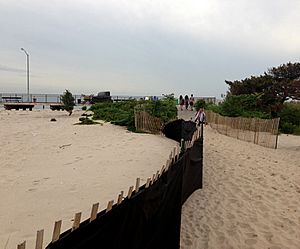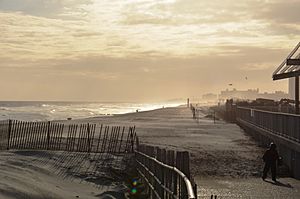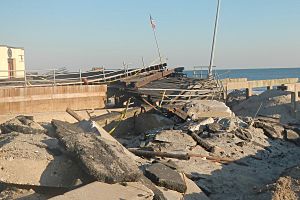Rockaway Beach and Boardwalk facts for kids
Quick facts for kids Rockaway Beach and Boardwalk |
|
|---|---|

Seen at sunset in 2019
|
|
| Location | Rockaway, Queens, New York |
| Area | 170 acres (69 ha) |
| Operated by | New York City Department of Parks and Recreation |
The Rockaway Beach and Boardwalk is a fun public park in Rockaway, Queens, New York. It has two main parts: the amazing Rockaway Beach (about 170-acre (69 ha)) and the long Rockaway Boardwalk (about 5.5-mile (8.9 km)). The sandy beach stretches for about 7 miles (11 km) from Beach 9th Street in Far Rockaway to Beach 149th Street in Neponsit. The concrete boardwalk runs from Beach 9th Street to Beach 126th Street in Rockaway Park. You can also find many cool sports areas and playgrounds here!
This beach became a popular vacation spot in the late 1800s. People started building parts of the boardwalk back then. The first city-owned section of the boardwalk was finished in 1923. Later, in 1925, the city planned a huge boardwalk that would go along most of the Rockaway coast. More sections were added between 1928 and 1930, and the last part was completed in 1963. Sadly, Hurricane Sandy badly damaged the boardwalk in 2012. But don't worry, it was rebuilt and reopened in stages by 2017!
The New York City Department of Parks and Recreation has taken care of the park since 1938. Park police help keep everyone safe.
Contents
Discover Rockaway Beach and Boardwalk
The Rockaway Beach and Boardwalk are managed by the New York City Department of Parks and Recreation (NYC Parks). They run side-by-side along the Rockaway peninsula. The park starts at Beach 9th Street in Far Rockaway on the east. It goes all the way to Beach 126th Street in Rockaway Park on the west.
The beach itself continues even further west to Beach 149th Street in Neponsit. There, it connects with the beach at Jacob Riis Park. The boardwalk is about 5.5 miles (8.9 km) long. The beaches cover a large area of 170 acres (69 ha) over 7 miles (11 km). In 1971, The New York Times newspaper said that the Rockaway Boardwalk was the second-longest in North America! Only the Atlantic City Boardwalk was longer.
The beach and boardwalk are next to different neighborhoods. Some parts, like those in Edgemere and Arverne, have quieter beaches. Other parts, like in Rockaway Beach, have lots of fun facilities and can get very busy.
You can easily get to the Rockaway Beach and Boardwalk by bus or subway. The Q22 bus runs nearby for most of the beach's length. The Q35 bus serves the western part, and the Q52 SBS, Q53 SBS buses serve the central part. Many New York City Subway stations on the IND Rockaway Line are also within walking distance. For example, the A S trains train serves stations like Beach 90th Street and Rockaway Park–Beach 116th Street. The A train train serves stations like Beach 25th Street and Beach 67th Street.
The Boardwalk's Design
The boardwalk was once made of different types of wood. But in 2012, Hurricane Sandy destroyed most of it. After the storm, the wooden boardwalk was completely rebuilt using strong concrete.
When it was first planned, the boardwalk was supposed to be almost 9 miles (14 km) long. It would have connected to the boardwalk in Jacob Riis Park. The plan was for it to be 80 feet (24 m) wide and about 14 feet (4.3 m) above the beach.
Today, the concrete boardwalk is mostly 40 feet (12 m) wide. It follows the same path as the old one, with a few small changes to make it straighter. There are wider "bump-out" areas (5 and 15 feet (1.5 and 4.6 m) wider) where you find stairs, ramps, and places to sit. The benches you see now are made from wood recycled from the old boardwalk!
The Beach's Features
The beach was created to be about 300 to 400 feet (91 to 122 m) wide. It used a huge amount of sand, about 2,500,000 cubic yards (1,900,000 m3)! Some parts of the beach in Arverne and Edgemere were made even wider (up to 1,000 feet (300 m)) because of strong ocean currents there. To stop the sand from washing away, special walls called jetties were built. These jetties extend from the boardwalk into the ocean.
From 1977 to 2004, the United States Army Corps of Engineers (USACE) worked to keep the beach healthy. They added more sand to create a 100-to-200-foot (30 to 61 m) wide strip of beach. The beach is also home to special plants that grow in sandy, coastal areas.
Rockaway Beach is the only beach in New York City that has good waves for surfing! All 7.5 miles (12.1 km) of the beach are watched over by lifeguards. In 2005, The New York Times reported that half of the city's lifeguards worked at Rockaway Beach. The beaches are usually busiest from Memorial Day in May to Labor Day in September. The only places in the city where surfing is allowed are at Rockaway Beach, between Beach 67th and 69th Streets, and between Beach 87th and 92nd Streets.
If you're on the western part of the beach (between Beach 126th and 149th Streets), where there's no boardwalk, you can get to the sand using stairs or ramps.
Fun Park Facilities
Rockaway Beach and Boardwalk has many cool places for sports and fun! You'll find basketball courts, handball courts, a roller-hockey rink, skateparks, and playgrounds. There are also places to buy food at Beach 17th, 86th, 97th, and 106th Streets. You can find restrooms at Beach 9th, 17th, 32nd, 60th, 86th, 97th, 106th, and 115th Streets.
In the Far Rockaway area of the park, there are three sets of recreational spots. O'Donohue Park, near Beach 9th Street, has a playground, ten handball courts, three basketball courts, restrooms, and the Far Rockaway Skate Park. Near Beach 17th Street, there's another playground and a baseball field. Between Beach 27th and 32nd Streets, you'll find the Beach 30th Street Playground and a football field.
In Arverne, there's a playground and handball courts at Beach 59th Street. Another playground, plus one basketball court and eight handball courts, are on the boardwalk's south side from Beach 74th to 77th Street. In Hammels, you'll find eight handball courts and two basketball courts west of Beach 81st Street, and two playgrounds at Beach 84th Street. In the Rockaway Beach neighborhood, there's the Rockaway Beach Skate Park at Beach 91st Street. There's even an ice hockey rink at Beach 109th Street!
Look out for "Whaleamena," a gray and aquamarine whale sculpture, at the Beach 95th Street entrance. It used to be at the Central Park Children's Zoo. A seal sculpture, also from Central Park, is on the boardwalk too. Along Shore Front Drive, you can see cool bus shelters from the 1939 New York World's Fair. They have murals with ocean themes, painted by Esther A. Grillo in 1997.
At Beach 116th Street, there's a special memorial for the people who died in American Airlines Flight 587. This plane crashed into the Rockaway peninsula in 2001. The memorial, finished in 2006, has a wall with the victims' names. It has windows and a doorway that look out to the Atlantic Ocean, pointing towards the Dominican Republic, where many victims were from. On top of the memorial, there's a quote in Spanish and English from a poet named Pedro Mir. It says, "Afterwards I want nothing more than peace."
History of Rockaway Beach
The Rockaway peninsula became a popular place for hotels by the 1830s. Many resorts were built along Rockaway Beach. The area became even more popular in the 1880s when the Long Island Rail Road built train lines to the area. This made it easier for people to visit.
Early Boardwalks and Growth
Before the big boardwalk, several smaller, unconnected sections were built in the late 1800s and early 1900s. These were usually near the resorts. For example, there was a 1-mile (1.6 km) section in Arverne and a 0.8-mile (1.3 km) section in Rockaway Park. The Rockaway area became part of City of Greater New York in the late 1890s. Fun amusement parks, like Rockaways' Playland, also opened along the beach.
The first boardwalk in Arverne was built in 1886. A new, longer one was built in 1900–1901. Hotels and a theater were built around it, but it was often damaged by storms. Other boardwalks were built in Hollands and Seaside in 1893, after a fire destroyed resorts there. These boardwalks had theaters, hotels, and even roller coasters!
Building the Big Boardwalk
Planning the Huge Project
By the 1910s, local groups wanted a long boardwalk built from Beach 58th Street to Beach 109th Street. They also wanted it to connect to Jacob Riis Park. The city even sent engineers around the world to study other boardwalks. They wanted to build the longest boardwalk in the world along the Rockaway shore!
The city started building a concrete boardwalk in Rockaway Park between Beach 109th and 126th Streets in 1922. This section opened in May 1923. It was 31 feet (9.4 m) wide and 4,500 feet (1,400 m) long. The city decided to buy more land along the shore to build the rest of the boardwalk.
In 1925, the city approved $8 million for beach improvements in Rockaway. They planned to add sand and build protective structures. The boardwalk was expected to be finished in three years. However, work was delayed for a year because of money issues. By 1926, the city approved more money and sped up plans for the section between Beach 59th and 109th Streets.
Connecting the Sections
In 1927, more money was approved for the first connecting section of the boardwalk. This part was between Beach 91st and 109th Streets. Some buildings had to be taken down to make way for the boardwalk. Work began in September 1927. This first section opened in June 1928. With this new part, more people wanted to buy land and build fun attractions along the shore.
Work on the second section, between Beach 75th and 56th Streets, began in 1928 and opened in June 1929. The third section, between Beach 56th and 21st Streets, started in late 1929 and opened in September 1930. This made the boardwalk much longer!
There were some disagreements about how much the city should pay property owners for their land. The payments were eventually lowered. The fourth section of the boardwalk, planned for east of Beach 21st Street, was delayed. This was because of ocean conditions and private land ownership.
Changes Over the Years
1930s to 1950s Updates
The long boardwalk had some big fires in the 1930s. In 1938, the New York City Department of Parks and Recreation (NYC Parks) took over caring for the boardwalk and beach.
Parks commissioner Robert Moses wanted to improve the area. He cleared a 200-foot ([convert: unknown unit]) strip of land north of the boardwalk to build Shore Front Parkway, which opened in 1939. He removed many old buildings and replaced them with sports fields. The beach was also made wider. By 1941, jukeboxes were not allowed on the boardwalk, and bicycling was banned in the summer.
In 1948, four parking lots were opened in the park. More parking lots were added in 1950. These lots were also used as play areas for kids when it wasn't summer. In the mid-1900s, Rockaway Beach was known as one of the best surfing spots in the New York metropolitan area. In the 1950s, the beach had 258 lifeguards, one of the largest groups in the world!
The beach lost a lot of sand over time. To fix this, New York State started a project in 1955. They added special walls and a lot of sand to protect the beach. By 1959, the beach was extended eastward to Beach 9th Street, and O'Donohue Park was built nearby. A new concrete section of the boardwalk was also built from Beach 9th to 19th Street in the early 1960s.
1970s to 2000s Repairs
Repairs were made to the boardwalk in the late 1960s or early 1970s. However, the wooden planks started to wear out. By 1971, NYC Parks thought about replacing the wood with plastic or concrete because it cost too much to fix. The central Rockaways area was also becoming less popular.
By 1973, 13 blocks of the beach had washed away, and parts of the beach had to close. The boardwalk was also falling apart. To help, the United States Army Corps of Engineers (USACE) started planning a project to protect the Rockaways from storms. A project to replace planks in 1975 was stopped because of the city's money problems. Work restarted in 1977.
In the late 1900s, the boardwalk also had some safety issues. The last amusement park, Rockaways' Playland, closed in 1987. However, in 1980, the New York Daily News said Rockaway Beach was cleaner than Coney Island's beach.
The Far Rockaway section of the boardwalk was named after Helen Leonescu in 1983. The USACE added sand to the beach every two years between 1980 and 1988. The beach was damaged again by a big storm in December 1992, but the boardwalk stayed mostly okay. Because of the sand loss, a section of the park was closed for at least three years. The USACE refilled the beach again between 1995 and 2004.
The boardwalk was improved in the 1990s. New play areas were built, and the boardwalk was repaired. Spray showers and drinking fountains were added, and the old bus shelters were fixed up. That part of the boardwalk reopened in 1999. The first surfing beaches in the city opened at Rockaway Beach in 2005 and 2007.
21st Century Rebuilding
In August 2011, Hurricane Irene damaged the boardwalk. NYC Parks spent $3.8 million to rebuild it for the summer of 2012.
Then, on October 29, 2012, Hurricane Sandy destroyed much of the Rockaway Boardwalk. The worst damage was between Beach 80th and 106th Streets. Some parts of the boardwalk were thrown into nearby houses! The mayor, Michael Bloomberg, announced in December 2012 that the boardwalk would be rebuilt with concrete instead of wood. The concrete sections that were already rebuilt before the hurricane had much less damage than the wooden parts.
Even though there was a lot of damage, the city promised to open all its public beaches by Memorial Day in May 2013. This included Rockaway Beach, where temporary ways to access the beach were set up. The city added more sand and fences to stop it from blowing away. New restrooms and lifeguard booths were also installed starting in 2013.
By September 2013, the city thought rebuilding the beach and boardwalk would cost $200 million. The project involved replacing the entire boardwalk and adding railings. The boardwalk project, costing $274 million, was split into five parts. Construction was funded by a $480 million grant from the Federal Emergency Management Agency in 2015.
The rebuilding was delayed for a few reasons. Funding was delayed, and plans had to be changed to include new flood protection. The old foundations also needed to be replaced. Also, construction had to avoid the nesting season of the piping plover, a special bird that nests on the beach from April to September.
In February 2014, workers started adding a huge amount of sand (2,900,000 cubic yards (2,200,000 m3)) to raise the beach by 10 to 14 feet (3.0 to 4.3 m). The first rebuilt section of the boardwalk opened in May 2015. The entire boardwalk rebuilding was finished in May 2017. The next year, the project won an award for its urban design.
Some of the sand from the beach had already washed away by 2017. The USACE got $400 million for more beach improvements. In November 2017, a study found that even with the erosion, the beach was wider than it had been in almost a century. The Rockaway Beach Skate Park, which was badly damaged by Hurricane Sandy, reopened in August 2020 after several years of delays.
Cultural Impact of Rockaway Beach
The park was the inspiration for the Ramones' 1977 song "Rockaway Beach". This song, from their 1977 album Rocket to Russia, became the American punk rock group's most successful single. It reached number 66 on the Billboard Hot 100 chart. The song was written in the style of Beach Boys music. It was composed by the band's bassist, Dee Dee Ramone, who loved spending time at the beach. In June 2013, the song was used in a radio ad campaign. This campaign encouraged New Yorkers to visit Rockaway Beach to help it recover after Hurricane Sandy.





